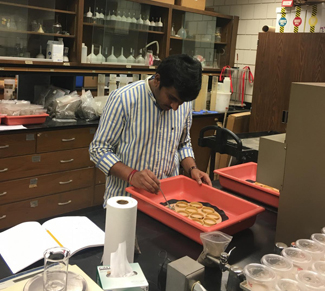 My name is Somanagouda B. Patil, and I’m an Indian citizen currently working at the International Center for Agricultural Research in the Dry Areas in Rabat, Morocco.
My name is Somanagouda B. Patil, and I’m an Indian citizen currently working at the International Center for Agricultural Research in the Dry Areas in Rabat, Morocco.
Since April, I’ve been a visiting scholar in CFAES’s Carbon Management and Sequestration Center through the support of the U.S. Department of Agriculture’s Borlaug International Agricultural Science and Technology Fellowship Program.
Under the supervision of Dr. Rattan Lal, Distinguished Professor in the School of Environment and Natural Resources and director of C-MASC, I am researching the impact of climate-smart agricultural practices on soil carbon sequestration and greenhouse gases emissions.
I received my bachelor of science in agriculture from University of Agricultural Sciences (UAS), Dharwad; my master of science in agronomy from UAS-Bangalore; and my PhD in agronomy from UAS-Dharwad and sandwich program with ICRISAT-India.
‘Urgent need’ for research on dealing with climate change
As a professional currently working in the field of agronomy and natural resource management, I understand the urgent need for innovative research to mitigate the alarming effects of climate change. It is with this realization that I found my calling. With a firm belief in the importance of sustainable agriculture, I’m conducting my research here at Ohio State on climate-smart agriculture, with a particular focus on conservation agriculture (no-tillage).

Researching how climate-smart agricultural practices impact soil respiration and carbon stability is critical because serious problems of land degradation, declining soil quality, reduced soil fertility, frequent drought and low agricultural production levels persist in the West Asia and North Africa (WANA) region. This is primarily due to years of inappropariate agricultural practices and climate change, the latter of which has further exacerbated these problems. While past agricultural research focused mainly on testing cropping systems under conventional soil management, this research may no longer be relevant to the adaptation and mitigation of the present changing climate. Most of WANA’s soils need improved management practices such as no-tillage with stubble retention to ensure resilient and sustainable agricultural production.
Working in both field and laboratory settings here at Ohio State, I am monitoring greenhouse gases emissions (i.e., CO2, CH4 and NO2); analyzing soil C and N stock; microbial biomass C; and soil physical properties like aggregate stability, saturated hydraulic conductivity, intrinsic permeability, pore size distribution, moisture characteristics, bulk density, porosity and tensile strength.
Work will ‘directly benefit’ farming communities
Through this Borlaug Fellowship, I am learning new dimensions of agronomic research. I am gaining experience in collaborating with other seasoned scientists and am improving my knowledge of climate-smart agriculture practices. My research experience at Ohio State has undoubtedly been a significant step toward achieving my long-term professional and personal goals. This program will not only broaden my knowledge but also my professional network, which is an exceptional opportunity for the horizontal exchange of experience and technical knowledge.
 After the Borlaug Fellowship Program concludes and I return to Morocco, I will be in a stronger position to begin research activities on climate-smart agriculture and to disseminate the technologies to international partners throughout the WANA region. Furthermore, I expect that this research will directly benefit farming communities by demonstrating the benefits of soil and water conservation and increasing crop yields in a region that is vulnerable to food insecurity and climate change.
After the Borlaug Fellowship Program concludes and I return to Morocco, I will be in a stronger position to begin research activities on climate-smart agriculture and to disseminate the technologies to international partners throughout the WANA region. Furthermore, I expect that this research will directly benefit farming communities by demonstrating the benefits of soil and water conservation and increasing crop yields in a region that is vulnerable to food insecurity and climate change.
My work will also introduce scientific and technical understandings into new contexts and to new researchers. Within academia, research on climate-smart practices is not only relevant to professional scientists, but also to students. The goal is to engage a wider audience of practicing scientists and farmers who want to understand how climate-smart agricultural practices will contribute to achieving sustainability in agriculture production. This research also serves as a key mechanism of collaboration between ICARDA and many U.S. land-grant universities, like The Ohio State University.
Thanks to USDA and Ohio State
I wish to thank the U.S. Department of Agriculture for its support for my program through the Borlaug International Agricultural Science and Technology Fellowship and The Ohio State University for hosting me for this fellowship program. Special thanks to Dr. Lal and the C-MASC team for their continuous support for my research, as well at the Office of International Programs in Agriculture for its management of my program.
(Photos, from top: Patil working in a research plot at the Ohio Agricultural Research and Development Center, CFAES’s research arm; working in CFAES’s Carbon Management and Sequestration Center; and at OARDC’s Western Agricultural Research Station in South Charleston.)